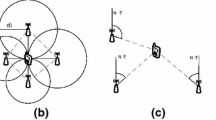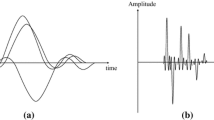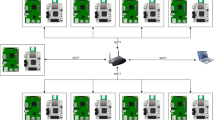Abstract
In this paper a method for ultra-wideband (UWB) localization for indoor applications is proposed. Beacons at known locations exchange signals with a tag to the purpose of estimating its position from range measurements. These measurements are accurate only when the ray corresponding to the direct path (DP) from tag to beacon is strong enough. In an UWB indoor environment, however, the DP may be blocked by thick walls or metallic obstacles, giving rise to large range errors. Several methods are available to mitigate this problem, exploiting different degrees of prior information. Techniques exploiting range error models or based on traditional fingerprinting lead to better results than methods that do not require any prior knowledge. We propose a new method that combines the maximum likelihood principle with range error models and special fingerprints. Its performance, assessed by simulation and compared to other techniques, is shown to be superior to traditional fingerprinting in the presence of environmental changes.
Similar content being viewed by others
References
Pahlavan K., Li X. (2002) Indoor geolocation science and technology. IEEE Communications Magazine 40(2): 112–118
Pahlavan K., Akgul F. O., Heidari M., Hatami A. (2006) Indoor geolocation in the absence of direct path. IEEE Wireless Communications 13(6): 50–58
Gezici S., Tian Z., Giannakis G. B., Kobayashi H., Molish A. F., Poor H. V. et al (2005) Localization via ultra-wideband radios. IEEE Signal Processing Magazine 22(4): 70–84
IEEE Standard 802.15.4a-2007 Task Group. Part 15.4: Wireless medium access control (MAC) and physical layer (PHY) specifications for low-rate wireless personal area networks (WPANs). Technical report, March 2007.
Sayed A. H., Tarighat A., Khajehnouri N. (2005) Network-based wireless location. IEEE Signal Processing Magazine 25: 24–40
Lee J-Y., Scholtz R. A. (2002) Ranging in a dense multipath environment using an UWB radio link. IEEE Transactions on Selected Areas in Communications 20(9): 1677–1683
Heidari, M., & Pahlavan K. (2007). A new error statistical model for the behavior of ranging errors in TOA-based indoor localization. In Proc. IEEE WCNC, (pp. 2566–2571).
Qi Y., Kobayashi H., Suda H. (2006) On time-of-arrival positioning in a multipath environment. IEEE Transactions on Vehicular Technology 55(5): 1516–1526
Qi Y., Kobayashi H., Suda H. (2006) Analysis of wireless geolocation in a non-line-of-sight environment. IEEE Transactions on Wireless Communications 5(3): 672–681
Bahl, P., & Padmanabhan, V. N. (2000). RADAR: An in-building RF-based user location and tracking system. In Proc. IEEE INFOCOM, (Vol. 2, pp. 775–784). Tel Aviv, Israel.
Steiner C., Wittneben A. (2010) Low complexity location fingerprinting with generalized UWB energy detection receivers. IEEE Transactions on Signal Processing 58(3): 1756–1767
Alavi B., Pahlavan K. (2006) Modeling of the TOA-based distance measurements error using UWB indoor radio measurements. IEEE Communications Letters 10(4): 275–277
Jourdan, D. B., Dardari, D., & Win, M. Z. (2006). Position error bound for UWB localization in dense cluttered environments. In Proc. international conference on communications, ICC 2006, (Vol. 8, pp. 3705–3710).
Chen, P-C. (1999). A non-line-of-sight error mitigation algorithm in location estimation. In Proc. IEEE wireless communications and networking conference, (pp. 316–320). New Orleans.
Li, X. (2006). An iterative NLOS mitigation algorithm for location estimation in sensor networks. In Proc. International mobile and wireless communications summit, Myconos, Greece.
Casas, R., Marco, A., Guerrero, J. J., & Falco, J. (2006). Robust estimator for non-line-of-sight error mitigation in indoor localization. EURASIP Journal on Applied Signal Processing, 2006, 1–8. doi:10.1155/ASP/2006/43429.
Rousseeuv P. J., Lery A. M. (2003) Robust regression and outlier detection. Wiley, Hoboken
Cong L., Zhuang W. (2005) Nonline-of-sight error mitigation in mobile location. IEEE Transactions on Wireless Communications 4(2): 560–573
Dardari, D., Conti, A., Lien, J., & Win, M. Z. (2008). The effect of cooperation on localization systems using UWB experimental data. EURASIP Journal on Applied Signal Processing, 2008, 1–11. doi:10.1155/2008/513873.
McGuire M., Plataniotis K. N., Venetsanopoulos A. N. (2003) Location of mobile terminals using time measurements and survey points. IEEE Transactions on Vehicular Technology 52(4): 999–1011
Author information
Authors and Affiliations
Corresponding author
Additional information
This work has been supported by the Spanish Government (Ministerio de Ciencia e Innovación, through the Projects CSD2008-00010 COMONSENS of the Consolider-Ingenio 2010 Program and TEC2009-14504-C02-02), by the European Union (FEDER) and by Junta de Andalucía (TIC-155).
Rights and permissions
About this article
Cite this article
Arias-de-Reyna, E., Mengali, U. A Maximum Likelihood UWB Localization Algorithm Exploiting Knowledge of the Service Area Layout. Wireless Pers Commun 69, 1413–1426 (2013). https://doi.org/10.1007/s11277-012-0642-2
Published:
Issue Date:
DOI: https://doi.org/10.1007/s11277-012-0642-2




